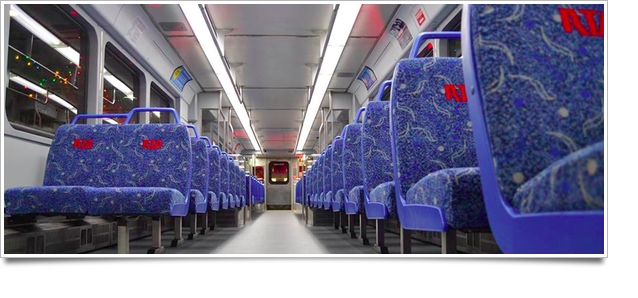By Joe Baur
All aboard, Northeast Ohio, or get left behind — but not in the creepy Kirk Cameron way.
Public transit is making a comeback across the country. Cleveland is no exception where RTA just posted their third year in a row of increased ridership. People are driving less and Millennials are purposely avoiding driving a car when possible.
But now we find ourselves at an interesting point in our transition. Clevelanders want better transit, but not without giving up a lane when driving. They want timely and efficient transit, but they aren’t holding the right people accountable.
I’ve followed public transportation closely in this country – specifically Cleveland – since returning to the area nearly three years ago and joining the volunteer RTA Citizen’s Advisory Board about a year-and-a-half ago. In my experience, there’s a disconnect between the general populace and how transportation works, much like any other complicated issue involving a public agency. Hell, I’m still learning every day and I love this stuff.
With that in mind, I decided I ought to share three things about public transportation that Clevelanders need to know. Hold onto your hats!
Where You Live Matters
This applies more to Greater Clevelanders than those within the city limits or first ring suburbs.
One of the unintended consequences of cars has been the creation of neighborhoods and exurbs solely around car ownership. We have towns without sidewalks and completely out of the range of public transit. Yet many of these folks complain that they would love a train to connect them from their home to their place of work. There’s a problem here. You can’t live 20 to 30 miles away from the urban core and expect the same level of service as those who live in the city.
Of course folks are entitled to weigh those pros and cons. That is, the peace and quiet of cul-de-sacs versus better connectivity. But what seems to get lost in this comparison is cost – both financial and opportunity.
Living in the exurbs may mean cheap rent or mortgage payment, but you there’s no getting around the fact that you need to own a car. Possibly two if both you and a significant other work in completely different directions. That’s $20,000 annually by AAA estimates of car ownership, including insurance, maintenance and fuel.
This is generally when people tell me, “You’re right! It is expensive. But RTA won’t send a train or bus out here.”
Well, where you live matters. You choose to leave the core, that’s your decision. But you cannot expect RTA to follow you out of the city. It’s not fiscally prudent for RTA to spend what little funding they have on servicing low-dense exurbs. If they did, it would be at the expense of those who decided to live in the city or inner-ring suburbs near transit infrastructure.
What you should do is consider what transit access there is before signing a lease. Consider where your employer is located. Talk to them about covering a monthly transit pass instead of parking. If they aren’t located near transit facilities, urge them to consider it. After all, plenty of smart businesses are relocating near transit infrastructure as workers have shown they prefer the opportunity to do work or read on a commuter line than drive in traffic.
Who You Should Be Mad At
Whenever a train or bus breaks down, RTA is going to hear about it from their riders. In fact, it seems when things run anything less than perfect, the pitchforks come out for RTA.
Now I’m not saying RTA is perfect. No organization is. But there’s a reason RTA has been recognized in various ways as a successful public agency both nationally and internationally. They are, I would argue, one of if not the best-run public agencies in the region. We are ultimately pretty damn lucky to have RTA.
What bothers me is the perception that RTA can do anything about many of the complaints they receive. Riders tell them to run more buses, not to cut lines, or they’re berated for running late. They threaten to give up RTA and just drive instead.
Yet when traffic jams fill up on the highway or construction makes commuting a little more difficult, drivers aren’t calling for ODOT’s head. And if there’s a public organization that deserves intense examination and ridicule, it’s ODOT, not RTA.
See, ODOT is the one making decisions that largely dictate RTA’s budget. In other words, how many buses they can run and whether or not they can expand service to give Clevelanders the regional transit system they deserve. It’s not fare jumpers, as I’ve seen suggested, that make or break RTA.
Unfortunately ODOT remains blissfully ignorant of transit trends. They continue to give public transportation just 1.5 percent of the state transportation budget, one of the worst in the country. We spend more on mowing grass along highways than we do on public transportation.
Simply put: If you’re pissed, be pissed at your state legislators for not representing your transportation needs.
“Bus” Is Not A Dirty Word
Everyone used to ride the bus. Unless you walked to school, you hopped on yellow bus five days a week for over 10 years of your life.
Then, as an adult working in the city, “bus” somehow became a dirty word. It’s a subtle (but not really subtle) understanding among friends and colleagues that the bus is for those people. People who are less financially fortunate than you or who look a little different.
Then the HealthLine came in, followed close behind by trolleys. Doctors started taking it to the Cleveland Clinic or University Hospital. The Rapid is as popular as ever for commuters and sports fans.
For some reason, those are okay to ride. Well, I’ve got some news for you. Some of you might want to sit down for this.
The HealthLine and trolleys are glorified buses.
Our beloved trolleys, asking us to smile for a free ride, are buses with a different coat of paint. The HealthLine is bus rapid transit. Until they run on rails, they are buses.
I point this out because there are an increasing amount of workers and visitors calling for trolleys between Downtown and Ohio City, to name one example. If that’s something you’d like to see, well then I have great news for you!
We already have them. They’re called the 20, 22, 79, 81, and of course, the Red Line Rapid.
The fact is that RTA shouldn’t have to throw a new coat of paint on those buses and launch a new marketing campaign to make people feel more comfortable. People take the bus. That’s how society rolls from Colombia to Switzerland. Nobody is above it or entitled to something different, because there are unfair socioeconomic connotations associated with it.
None of this to say that there aren’t areas for improvement at RTA. NextConnect, for example, will finally see an update this month that should address consistency issues.
Ultimately, the point of all this is to take that rage from a missed bus or delayed train and redirect it to the people and organization that can actually do something about it – your public officials and the Ohio Department Of Transportation.
[Photo via RTA’s Facebook page]
 Joe Baur is a freelance writer, filmmaker and satirist with a diverse array of interests including travel, adventure, craft beer, health, urban issues, culture and politics. He ranks his allegiances in the order of Cleveland, the state of Ohio and the Rust Belt, and enjoys a fried egg on a variety of meats. Joe has a B.A. in Mass Communication with a focus on production from Miami University. Follow him at http://JoeBaur.com and on Twitter @BaurJoe.
Joe Baur is a freelance writer, filmmaker and satirist with a diverse array of interests including travel, adventure, craft beer, health, urban issues, culture and politics. He ranks his allegiances in the order of Cleveland, the state of Ohio and the Rust Belt, and enjoys a fried egg on a variety of meats. Joe has a B.A. in Mass Communication with a focus on production from Miami University. Follow him at http://JoeBaur.com and on Twitter @BaurJoe.

5 Responses to “Three Things Clevelanders Should Know About Transit”
Penny Jeffrey
Buses are OK–I frequently take them into downtown Cleveland. But the loss of the commuter flights at CLE demonstrates why we need RAIL connects to cities like Columbus, Pittsburgh and Toledo. We need RAIL to cities east, west and south.
Ed
ODOT is only a symptom because ODOT only does what the executive and legislative branches of government tell it to do. Furthermore, the Ohio constitution restricts gas tax money– almost all of of the funding ODOT receives– to only be spent on roads. If you really, truly want better and expanded transit we need to focus our anger and frustration where it will do the most good: on the governor’s office and the legislature. In the meantime, bypass them whenever and wherever you can by organizing at the local level to find alternative ways to pay for transit projects.
Joe Baur
Right on with commuter flights and the need for regional rail, Penny. It’s actually the subject of my next piece.
Allen Freeman
I would be 100% for regional rail if it were set up like a private-venture airline. The cities can build/lease the ‘terminals’ but the trains and their operation and marketing should be done by private companies. Let the competition begin!
artem1s
Are there ANY plans to include a dedicated bus line or lite rail in the Opportunity Corridor proposal? Doctors may be using the Health Line now but its clear that the OC is being structured to provide a quick route (cars) from affluent exburbs to University Circle so that the Clinic’s clients and upper crust docs and management don’t have to interact with the poors who populate the neighborhoods that the OC is cutting across. A plan structured like the Euclid Corridor project might actually provide some opportunities for those neighborhood instead of isolating them from the limited access highway that is currently being proposed by planners (and I’m assuming ODOT). throwing in a couple of painted lines and calling them bike lanes isn’t going to help the fact that the current plan only has limited pedestrian crosswalks occurring every half mile or less. Not very friendly for current residents who don’t want or can’t afford to buy a car to get to the other side of the road. It’s not helpful when ODOT keeps killing the city transit improvements with their pass thru highway attitudes. ODOT”s unwillingness to bend to the suggestions of the actual communities affected by the Innerbelt project does not leave me hopeful that the Opportunity Corridor public hearing process will be any better in the end.